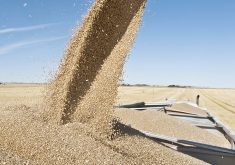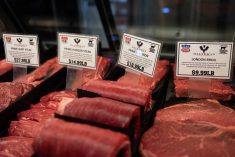Speculators are flocking to corn in droves, which could spark a fall rally in grain prices, though nothing like what was seen in 2008, says a grain industry analyst.
“As we head into the fall, things could get a little turbulent in the grain markets again,” said Geoff Cooper, vice-president of research with the U.S. Renewable Fuels Association.
The Commodity Futures Trading Commission reports that non-commercial investors, such as hedge and index funds, held 404,371 net long positions in nearby corn futures last week.
Read Also

Soybean market still figuring out implications of China-U.S. pact
Soybean futures had a muted reaction to the U.S. trade deal with China as the market tries to figure out the nuances of the deal.
That tops the 360,000 held by investment speculators in mid-May 2008, the height of the corn price bubble that helped lift all grain prices.
A record 556,034 futures contracts, representing 71 million tonnes of the commodity, changed hands Sept. 3, the busiest day in corn trading in the Chicago Board of Trade’s 133-year history.
Cooper said the more than $1 US per bushel increase in corn prices since June is not all speculator driven. Sound supply and demand fundamentals are also behind it.
The U.S. Department of Agriculture has sliced Russia’s expected 2010-11 wheat output to 42.5 million tonnes from 61.7 million tonnes a year ago, which is bullish for U.S. corn exports.
USDA also slashed 2010-11 U.S. corn production by 5.4 million tonnes late last week from its August estimate.
Those developments, along with a stagnant stock market, are luring speculator dollars into corn, which is raising expectations for a further price hike in the commodity.
“There is the potential for bubble-like dynamics this fall,” Cooper said.
He doesn’t anticipate the same extreme market response that occurred in 2008, when corn prices peaked at $7.88 per bu. June 26, up from around $4 per bu. in December 2007.
There is a different economic environment today. Oil prices are not soaring as they were in 2008, the U.S. housing market isn’t in crisis and the stock market hasn’t slumped badly as it did in the second half of 2008.
However, Cooper does anticipate market volatility in grain and oilseed prices this fall.
“Movements in the market become significantly more exaggerated when you have this many speculators,” he said.
The market highs will be higher and the lows will be lower if the bubble bursts because Russia’s wheat damage turns out to be not as bad as now expected, the U.S. corn crop is bigger than anticipated or if global demand is lower than expected.
“As fast as prices run up, they can certainly collapse just as quickly,” he said.
The Renewable Fuels Association is concerned that heated grain markets will reignite the simmering food vs. fuel debate and the biofuel industry will once again be fingered as the culprit.
There have already been riots over high bread prices in Mozambique and reports of political tension in South Africa, Egypt and Serbia due to rising food costs.
Cooper said other corn users such as the livestock sector and the Grocery Manufacturers Association falsely blamed the ethanol industry for causing record grain prices in 2008.
He said influential organizations such as the World Bank that initially blamed the biofuel industry have since concluded speculators played a much bigger role in the 2008 price spike than ethanol plants.
Cooper said the food versus fuel debate has severely hampered the renewable fuel sector’s ability to build political and popular support for ethanol and biodiesel.
“It was tremendously damaging. We still hear echoes of the food versus fuel argument two years after the fact.”
As a result, the industry doesn’t want to see a repeat of 2008.
“That’s why we’re starting to get a little concerned about the number of speculators in the marketplace,” Cooper said.















